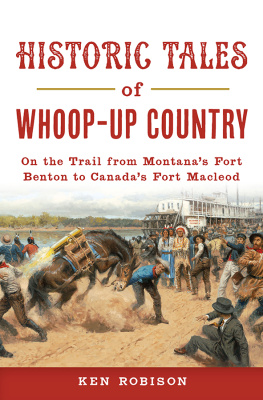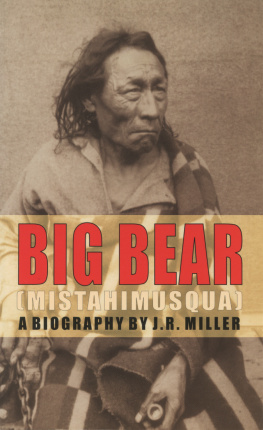ABOUT THE AUTHOR
HUGH A. DEMPSEY IS AN author, historian, and researcher. He is the former associate director at the Glenbow Museum, Calgary, and is currently its chief curator emeritus. He is also editor of the quarterly Alberta History .
Dempsey holds a number of honours, including the Order of Canada, an honorary doctorate from the University of Calgary, an honorary chieftainship of the Blood tribe, the Sir Frederick Haultain Award for Excellence, an Alberta Booksellers Award, an Alberta Non-Fiction Award, and a life membership in the Calgary Exhibition and Stampede. Dempsey is the author of twenty books on western Canadian history and has edited another seventeen. He has written nine monographs and more than two hundred articles for periodicals, books, and newspapers. He is a well-known lecturer and specialist on the history of the Indigenous peoples of western Canada and the early history of Alberta. Among the books he has written are Maskepetoon: Leader, Warrior, Peacemaker ; Crowfoot: Chief of the Blackfeet ; The Golden Age of the Canadian Cowboy ; and The Vengeful Wife and Other Blackfoot Stories .
Dempsey lives in Calgary. He is married to Pauline (ne Gladstone) of the Blood tribe, and they have five children, eleven grandchildren, and two great-grandchildren.
Praise for The Great Blackfoot Treaties
The Great Blackfoot Treaties is a gift we should all appreciate. It not only draws together in masterful fashion the scattered extant evidence, both oral and documentary, Native and white, that Hugh Dempsey as researcher, interviewer, author, archivist, and editor has so assiduously collected and contributed to, but it presents a historical picture and a synoptic treaty analysis that is so balanced, so clearly written, and so insightful, particularly from the Blackfoot side, as to be conclusive.
WILLIAM E. FARR, professor, OConnor Center for the Rocky Mountain West, University of Montana
Dempseys eloquent display of storytelling captures the spirit and intent of both the Blackfoot leaders and government agencies. A moving journey that brings to life the Blackfoot people and their enduring treaty-making processes throughout the centuries. A must-read for historians and their students as they move forward in questioning the ethics of interpreting the present-day treaties and Canadian governmentFirst Nations relations.
ANNETTE BRUISED HEAD, Kainai High School Principal, Blood Tribe
The Great Blackfoot Treaties contributes new information and new perspectives. The result of two-thirds of a century of research and writing on the First Nations in southern Alberta, it adds new depth to our understanding of the treaties between the First Nations themselves and the American and Canadian governments. The drama behind the making of Treaty Seven makes for exciting reading. A great read by the Dean of Alberta historians.
DONALD B. SMITH, Professor Emeritus of History, University of Calgary
Pacts of war, peace, and territory have long been negotiated by the Blackfoot with their Native counterparts, and later with the American and Canadian governments. Hugh Dempsey successfully numerates the surrounding events of treaty creations. This vital and nuanced recounting is timely, as modern Aboriginal society assesses its future course amid a sea of critical oversimplifications.
GORDON E. TOLTON, author of Healys West and Cowboy Cavalry
Dr. Hugh Dempsey, the most prolific writer of Blackfoot history, brings together the histories, historical actors, complex motivations, and, most importantly, the voices of Native people in The Great Blackfoot Treaties . In this easy-to-read and highly informative book, Dr. Dempsey shares his years of research and, as his readers have come to expect, provides fascinating historical details of northern Great Plains life. He challenges several commonly held conceptions: Were tribal leaders unable to think for themselves? Did they blindly follow the advice of non-Natives? Or did they act on their own accord when negotiating treaties?
Dr. Dempsey begins before the arrival of Europeans and Americans and tells the fascinating story of how tribes made agreements with each other for peace, land, and resource use. He then moves us forward as tribes developed formal and informal relationships with traders. Dr. Dempsey reasons that by the arrival of national governments on the borderland between the U.S. and Canada, tribes on the northern Great Plains understood the underlying concepts of formal arrangements between sovereign entities.
As Native issues move to the forefront of national consciousness in the twenty-first century, The Great Blackfoot Treaties provides an excellent primer on the history of treaties, reminding us why they are so important, not just to Native people but to everyone, and how they still serve as the basis for the complex relationships between First Nations and national governments.
ROSALYN LA PIER (BLACKFEET/MTIS), Assistant Professor, Environmental Studies, University of Montana
The Great
BLACKFOOT
TREATIES
HUGH A. DEMPSEY
Copyright 2015 Hugh A. Dempsey
All rights reserved. No part of this publication may be reproduced, stored in a retrieval system, or transmitted in any form or by any meanselectronic, mechanical, audio recording, or otherwisewithout the written permission of the publisher or a licence from Access Copyright, Toronto, Canada.
Heritage House Publishing Company Ltd.
heritagehouse.ca
CATALOGUING INFORMATION AVAILABLE FROM LIBRARY AND ARCHIVES CANADA
978-1-77203-078-5 (pbk)
978-1-77203-079-2 (epub)
978-1-77203-080-8 (epdf)
Edited by Audrey McClellan
Proofread by Lesley Cameron
Cover design by Jacqui Thomas
Cover illustrations: 991.17.1, Nicholas Grandmaison, Chief Crowfoot, oil on canvas,
Collection of Glenbow, Calgary, Canada ( top ); Sydney Prior Hall, Chief Crowfoot Addresses Governor-General the Marquis de Lorne at Blackfoot Corssing, early 1880s, pastel and chalk. #23272 canadianheritage.org, National Archives of Canada C-121918 ( bottom ).
Heritage House acknowledges the financial support for its publishing program from the Government of Canada through the Canada Book Fund (CBF), Canada Council for the Arts, and the Province of British Columbia through the British Columbia Arts Council and the Book Publishing Tax Credit.



FOREWORD
THIS BOOK HAD ITS BEGINNING at an Indian Association of Alberta meeting in 1951 when, as a reporter for the Edmonton Bulletin , I was left wondering why all the speakers placed such an emphasis on treaties. Obviously they were important, as they were associated with Queen Victoria, but that was almost seventy-five years ago. Surely they were of no particular importance in 1951. Yet as I listened, I came to realize that the treaties were more than just pieces of paper. They were promises upon which the whole future of the Native people ultimately depended. The Natives gave up their rights to their hunting grounds, and in exchange the government took on the responsibility for their future. Buffalo hunters had to be taught how to become farmers or ranchers, and education was needed if their children were to survive under the new order.
A few years later, when I was writing a biography of Crowfoot, I found out just how important Treaty Seven was to him and his followers. Their whole reservation system, their commitment to education, and the very existence of the Blackfoot people depended on the government helping them adjust to a new life. In exchange, the Blackfoot surrendered their lands and, ultimately, their freedom.








